
By Matthew F. Manion
As of this writing, masses are being celebrated in St. Peter’s Basilica in Rome for the first time in 10 weeks. Throughout the United States, individual states and local jurisdictions are creating guidelines for religious gatherings as they begin to reopen their governments.
As churches around the globe begin to open their doors again, steps are being taken to ensure a careful balance between providing for the faithful’s spiritual well-being while ensuring their physical health and safety amid the global pandemic.
This is uncharted territory for all, but there are several things church leaders can do to prepare their churches and their faithful.
From an operational perspective, churches need to consider how to implement CDC guidelines and recommendations. This includes ensuring the health and safety of staff by providing sufficient personal protective equipment (PPE).
For example, at St. Patrick’s Cathedral in New York City, Kevin Donohue, Director of Building Operations, has ordered 12,000 masks so employees have enough to switch them a few times a shift if necessary. With nearly 80 employees, St. Patrick’s is obviously larger than most churches — but this is an example of how to think ahead on a broad scale.
Churches should also be procuring sanitizing equipment and tools. In adherence to CDC recommendations, sanitation staff should already be maintaining regular cleaning and disinfecting in preparation for reopening.
St. Patrick’s is using a fogging disinfectant similar to that being used in St. Peter’s in Rome and other churches and businesses around the globe. And many churches are installing plexiglass at various points where the staff and public interact, including staff offices and common areas inside churches like confessionals.
Just as many have encountered shortages of toilet paper and disinfectant wipes, churches might find it difficult to secure PPE and hand sanitizer, so it’s important to plan ahead. Some churches are exploring alternative solutions for hand sanitizer amidst shortages, including sourcing sanitizer from local distilleries — with the added benefit of supporting a local small business.
The Thomistic Institute in Washington, D.C. has created detailed guidelines for Catholic mass that can be applicable to all houses of worship. To ensure 6 feet of separation among the faithful, the Institute recommends pews to be sectioned off and only members of the same household permitted to sit together. Tape can be used on the ground to ensure physical distancing while entering, exiting and moving throughout the building.
In addition to many of the physical requirements mentioned above, the Institute guidelines also include general pastoral recommendations to ensure the public health and safety. These include offering dispensation from the Sunday mass obligation, encouraging high-risk individuals to stay home, and of course, requiring all those who are sick to stay home.
To limit the size of the congregation, churches might choose to offer mass more frequently, and with the potential removal of the Sunday obligation, encourage mass attendance Monday through Saturday instead. In addition, ticketing and reservation systems might be used to organize the limited church attendance.
Drive-in or outdoor services might be used where feasible.
Hymnals and missalettes can transmit the virus if left in the pews and handled by multiple worshippers. They might be replaced with large TV monitors or an app on your phone to follow readings and liturgical responses. And songs might be suspended, as evidence has shown the virus is more likely to be spread by singing than speaking.
Clearly, this will be a very different physical church experience for everyone. As so many of our faith traditions are rooted in familiar rituals, it will be critical to prepare and train the faithful for what to expect when they are able to return to houses of worship. Communication should be absolutely clear and consistent to avoid chaos. The faithful should know that these measures are being taken to ensure the health and safety of everyone. New protocols should be clear and easy to follow to ensure adherence.
The fundamentals of our faith and spirituality remain the same, yet there is no doubt that church will be different as we move forward. Leaders need to discern an appropriate, yet delicate, balance between offering spiritual good and preventing physical harm.
In finding that balance, we must ensure the experience of going to church does not simply become a transactional experience. Church should not feel like a trip to the grocery store. The plexiglass, hand sanitizer stations, masks and the tape on the floors might make it feel so.
Church leaders need to train and form their people to best maintain the spiritual and physical health of their community in this very different new world.

Matthew F. Manion is Professor of Practice in Management and Operations and Faculty Director for the Center for Church Management at Villanova School of Business.


